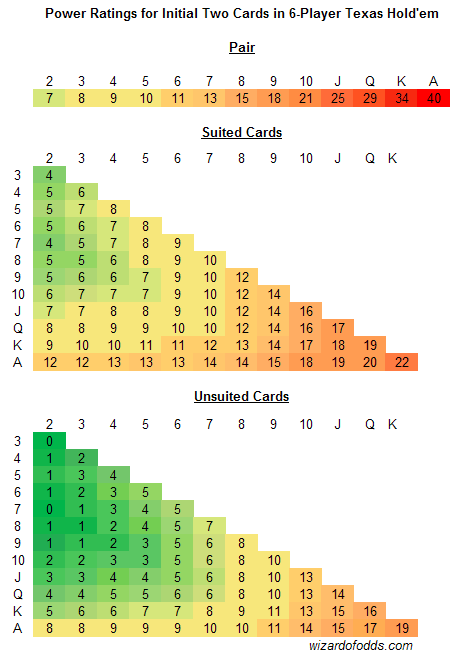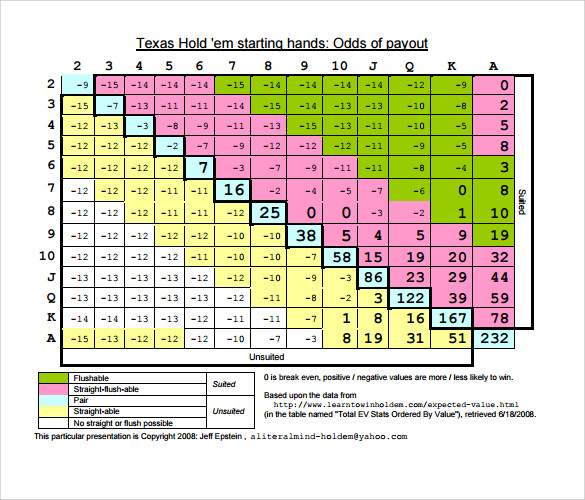Poker Expected Value Starting Hands

Video Poker Percentage. 18+, T&C Apply, New Customers Only. Registering your account. By opening an account with us and/or by using the Website you acknowledge, agree and Poker Expected Value Starting Hands warrant that you:. are at least 18 years of age and above the legal age for gambling in the jurisdiction you are a. Expected Value Chart by Position. These statistics were compiled by a major online poker room from an expected value page from their database of millions of real live hands. Positive expectation hands are indicated by black numbers while negative expectation hands are indicated by red numbers. EV means “expected value”. In poker, this refers to the average amount of money a player can expect to win or lose by taking a certain action during a hand. In this article, we will review the details of EV, including how to calculate it, how to use it effectively to boost your profits, and how it might be used in certain hypothetical examples that have been created. It’s all well and good learning about the basics of expected value with coin flips, but how does expected value apply to poker? It’s pretty much the same thing, so let’s look at a straightforward expected value example with a flush draw. Our hand: A 2 Board: Q K 3 7. The pot is $100 and our opponent moves all-in for $50. The 1,326 starting hands can be reduced for purposes of determining the probability of starting hands for Hold 'em—since suits have no relative value in poker, many of these hands are identical in value before the flop. The only factors determining the strength of a starting hand are the ranks of the cards and whether the cards share the same.
Poker Value Hands
In the poker game of Texas hold 'em, a starting hand consists of two hole cards, which belong solely to the player and remain hidden from the other players. Five community cards are also dealt into play. Betting begins before any of the community cards are exposed, and continues throughout the hand. The player's 'playing hand', which will be compared against that of each competing player, is the best 5-card poker hand available from his two hole cards and the five community cards. Unless otherwise specified, here the term hand applies to the player's two hole cards, or starting hand.

Essentials[edit]
There are 1326 distinct possible combinations of two hole cards from a standard 52-card deck in hold 'em, but since suits have no relative value in this poker variant, many of these hands are identical in value before the flop. For example, A♥J♥ and A♠J♠ are identical in value, because each is a hand consisting of an ace and a jack of the same suit.
Therefore, there are 169 non-equivalent starting hands in hold 'em, which is the sum total of : 13 pocket pairs, 13 × 12 / 2 = 78 suited hands and 78 unsuited hands (13 + 78 + 78 = 169).
These 169 hands are not equally likely. Hold 'em hands are sometimes classified as having one of three 'shapes':
- Pairs, (or 'pocket pairs'), which consist of two cards of the same rank (e.g. 9♠9♣). One hand in 17 will be a pair, each occurring with individual probability 1/221 (P(pair) = 3/51 = 1/17).
- Alternative means of making this calculation
- First Step
- As confirmed above.
- There are 1326 possible combination of opening hand.
- Second Step
- There are 6 different combos of each pair. 9h9c, 9h9s, 9h9d, 9c9s, 9c9d, 9d9s. Therefore, there are 78 possible combinations of pocket pairs (6 multiplied by 13 i.e. 22-AA)
- To calculate the odds of being dealt a pair
- 78 (the number of any particular pair being dealt. As above) divided by 1326 (possible opening hands)

- 78/1326 = 0.058 or 5.8%
- Suited hands, which contain two cards of the same suit (e.g. A♣6♣). 23.5% of all starting hands are suited.
Probability of first card is 1.0 (any of the 52 cards)Probability of second hand suit matching the first:There are 13 cards per suit, and one is in your hand leaving 12 remaining of the 51 cards remaining in the deck. 12/51=.2353 or 23.5%
- Offsuit hands, which contain two cards of a different suit and rank (e.g. K♠J♥). 70.6% of all hands are offsuit hands
Offsuit pairs = 78Other offsuit hands = 936
It is typical to abbreviate suited hands in hold 'em by affixing an 's' to the hand, as well as to abbreviate non-suited hands with an 'o' (for offsuit). That is,
- QQ represents any pair of queens,
- KQ represents any king and queen,
- AKo represents any ace and king of different suits, and
- JTs represents any jack and ten of the same suit.
Limit hand rankings[edit]
Some notable theorists and players have created systems to rank the value of starting hands in limit Texas hold'em. These rankings do not apply to no limit play.
Sklansky hand groups[edit]
David Sklansky and Mason Malmuth[1] assigned in 1999 each hand to a group, and proposed all hands in the group could normally be played similarly. Stronger starting hands are identified by a lower number. Hands without a number are the weakest starting hands. As a general rule, books on Texas hold'em present hand strengths starting with the assumption of a nine or ten person table. The table below illustrates the concept:
Chen formula[edit]
The 'Chen Formula' is a way to compute the 'power ratings' of starting hands that was originally developed by Bill Chen.[2]
- Highest Card
- Based on the highest card, assign points as follows:
- Ace = 10 points, K = 8 points, Q = 7 points, J = 6 points.
- 10 through 2, half of face value (10 = 5 points, 9 = 4.5 points, etc.)
- Pairs
- For pairs, multiply the points by 2 (AA=20, KK=16, etc.), with a minimum of 5 points for any pair. 55 is given an extra point (i.e., 6).
- Suited
- Add 2 points for suited cards.
- Closeness
- Subtract 1 point for 1 gappers (AQ, J9)
- 2 points for 2 gappers (J8, AJ).
- 4 points for 3 gappers (J7, 73).
- 5 points for larger gappers, including A2 A3 A4
- Add an extra point if connected or 1-gap and your highest card is lower than Q (since you then can make all higher straights)
Phil Hellmuth's: 'Play Poker Like the Pros'[edit]
Phil Hellmuth's 'Play Poker Like the Pros' book published in 2003.
| Tier | Hands | Category |
|---|---|---|
| 1 | AA, KK, AKs, QQ, AK | Top 12 Hands |
| 2 | JJ, TT, 99 | |
| 3 | 88, 77, AQs, AQ | |
| 4 | 66, 55, 44, 33, 22, AJs, ATs, A9s, A8s | Majority Play Hands |
| 5 | A7s, A6s, A5s, A4s, A3s, A2s, KQs, KQ | |
| 6 | QJs, JTs, T9s, 98s, 87s, 76s, 65s | Suited Connectors |
Statistics based on real online play[edit]
Poker Expected Value Calculator
Statistics based on real play with their associated actual value in real bets.[3]
| Tier | Hands | Expected Value |
|---|---|---|
| 1 | AA, KK, QQ, JJ, AKs | 2.32 - 0.78 |
| 2 | AQs, TT, AK, AJs, KQs, 99 | 0.59 - 0.38 |
| 3 | ATs, AQ, KJs, 88, KTs, QJs | 0.32 - 0.20 |
| 4 | A9s, AJ, QTs, KQ, 77, JTs | 0.19 - 0.15 |
| 5 | A8s, K9s, AT, A5s, A7s | 0.10 - 0.08 |
| 6 | KJ, 66, T9s, A4s, Q9s | 0.08 - 0.05 |
| 7 | J9s, QJ, A6s, 55, A3s, K8s, KT | 0.04 - 0.01 |
| 8 | 98s, T8s, K7s, A2s | 0.00 |
| 9 | 87s, QT, Q8s, 44, A9, J8s, 76s, JT | (-) 0.02 - 0.03 |
Nicknames for starting hands[edit]
In poker communities, it is common for hole cards to be given nicknames. While most combinations have a nickname, stronger handed nicknames are generally more recognized, the most notable probably being the 'Big Slick' - Ace and King of the same suit, although an Ace-King of any suit combination is less occasionally referred to as an Anna Kournikova, derived from the initials AK and because it 'looks really good but rarely wins.'[4][5] Hands can be named according to their shapes (e.g., paired aces look like 'rockets', paired jacks look like 'fish hooks'); a historic event (e.g., A's and 8's - dead man's hand, representing the hand held by Wild Bill Hickok when he was fatally shot in the back by Jack McCall in 1876); many other reasons like animal names, alliteration and rhyming are also used in nicknames.
Notes[edit]
- ^David Sklansky and Mason Malmuth (1999). Hold 'em Poker for Advanced Players. Two Plus Two Publications. ISBN1-880685-22-1
- ^Hold'em Excellence: From Beginner to Winner by Lou Krieger, Chapter 5, pages 39 - 43, Second Edition
- ^http://www.pokerroom.com/poker/poker-school/ev-stats/total-stats-by-card/[dead link]
- ^Aspden, Peter (2007-05-19). 'FT Weekend Magazine - Non-fiction: Stakes and chips Las Vegas and the internet have helped poker become the biggest game in town'. Financial Times. Retrieved 2010-01-10.
- ^Martain, Tim (2007-07-15). 'A little luck helps out'. Sunday Tasmanian. Retrieved 2010-01-10.
NL Hold’em Starting Hand Charts
One aspect of the game of No-Limit Hold’em that causes beginning players much grief is deciding which hands to play and which hands to dump. NL Hold’em is much more difficult than Limit Hold’em because the value of a hand depends on so many factors other than just the cards in your hand. Despite this difficulty, our coaches believe that following some general guidelines and adjusting from these is a better solution than having no guidelines at all. Given that well over half of your profitability in NL Hold’em is based on hand selection alone, we have developed these charts to help you better determine whether to play or fold.
There are no perfect No-Limit starting hand charts. That is because there are many factors that affect your decision, and charts cannot account for all of them. Some of these include:
- The size of your opponent's stacks.
- How loose or tight, passive or aggressive, your opponents are.
- Where these opponents are located at the table – for example, does an aggressive player still have to act after you?
- Your image at the table – for example, how tight or tricky you are perceived.
That being said, these charts will serve you well in most typical low-stakes No-Limit cash games, such as games with blinds of $1/$2, and home games. These games typically have several loose players at the table, and good opportunities for winning big pots with suited connectors and pocket pairs. With practice, you will be able to be a consistently winning player with these charts as a starting point. As you improve, you'll find yourself making adjustments to these charts based on the factors listed above, and more.
AGAIN: These charts are a good starting point for beginners. Specifically, Chart #1 recommends a significant amount of limping. This is great in loose, passive games but less often seen in tougher games. You’ll find other training material on Advanced Poker Training that may recommend a more aggressive approach for more experienced players.
Note: It would be a serious mistake to apply these hand charts before reading the Frequent Asked Questions first.
CHART #1 ‐ LOOSE, PASSIVE GAME (OFTEN 4-5 LIMPERS PER HAND)
NO ONE HAS RAISED YET
- Raise Always
- Call from Early Position, otherwise raise
- Call always
- Call from Middle or Late Position if the conditions are right (see Frequently Asked Questions)
CHART #2 ‐ TIGHTER GAME (FEWER LIMPERS) OR MORE AGGRESSIVE GAME
NO ONE HAS RAISED YET
- Raise Always
- Call from Early Position, otherwise raise
- Call (or Raise) from Middle or Late Position if the conditions are right (see Frequently Asked Questions)
CHART #3 ‐ THERE HAS BEEN A SINGLE RAISE
(3‐5 TIMES THE BIG BLIND) BEFORE YOU
- Re‐Raise Always
- Call from Early Position, otherwise re‐raise
- Call always
- Call from Middle or Late Position if the conditions are right (see Frequently Asked Questions)
FREQUENTLY ASKED QUESTIONS
For the hands in yellow, what do you mean when you say to play these hands if the conditions are right? The hands in yellow are speculative hands. They should always be folded from Early Position. From other positions, they can be profitable given the right conditions. Some of the questions to ask yourself:
- Are there other players who have called so far (the more, the better)?
- Are the players who have called playing poorly after the flop? Will they pay me off if I hit something?
- Is there an aggressive player still to act behind me (you might get raised and have to fold)?
- If there has been a raise and no other callers, what chance do I have of using my position after the flop to win the hand even if I don't improve (Chart #3 only)?
Why does Chart #2 say to sometimes raise with the hands in yellow, but Chart #1 does not? We have different goals in mind. Using Chart #1, we want to call to encourage additional players to enter the pot. These hands will be immensely profitable when our loose, passive opponents enter the hand, and get trapped when we flop a set, or make a well-disguised straight. When using Chart #2, however, we want to size up the opponents still to act. If they are tight, we can raise. Sometimes, we'll pick up the blinds. Other times, our pre-flop aggression will allow us to take down the pot on the flop.
Poker Hand Values Chart
What's the difference between AKs and AKo? AKs means an Ace and King of the same suit. AKo means an Ace and King of different suits.
What are early, middle, and late position? Early Position is generally the first 2 (in a nine player game) or 3 (in a ten player game) positions after the blinds. Late Position is the “cutoff” position (to the right of the dealer), and dealer button positions. Middle Position is everything in between.
How much should I raise? As a general rule, raise 3 to 4 times the big blind, plus 1 extra big blind for every player who has called before you. So if there are 2 callers already, raise between 5 and 6 times the big blind.
What if someone raises after I call? Whether you call the raise depends on how much money the raiser has for you to win, how many other players are involved, and what type of hand you have. As a general rule, if you have a pocket pair, lean towards calling. If there are a lot of other players (and therefore a big pot), lean towards calling. In general, fold suited connectors from early position. Fold hands like KQ that don't play well against a raiser.
How do I play from the blinds? From the small blind, play the same hands you would play from late position, plus a few more. But don't call with junk hands like T5o, just because it is “cheap”. From the big blind, if there is a raise to you, play like you would if you had already called from early position.
The chart says to fold KQo to a raise. Really? Yes, this hand performs very poorly against typical raising hands. Against AK, AQ, AA, KK, QQ, you are a big underdog. Other typical raising hands like JJ, TT, 99, AJs, are slightly ahead of you as well. The only time you might call or re-raise is from late position, if the opener was in middle or late position, indicating they might have a wider range of hands.
I was told to fold AJo from Early Position, why do you say to call with it? Folding AJo is not a bad idea in many games. We included it because, at low stakes tables (even tight or aggressive ones), the players are often playing badly enough after the flop that it can be profitable. We used data from millions of hands of low-limit poker to analyze this. The same could be said for KQo, ATs, and KJs – you can make a small profit in the long run at most low-stakes games, but folding would be perfectly acceptable from early position.
Can I use these charts in a NL Hold'em tournament? The charts would be best applicable to the early stages of a NL tournament, when everyone has a deep stack. In the middle and later stages, they should not be used.
